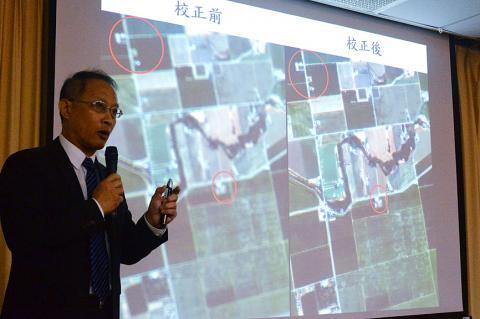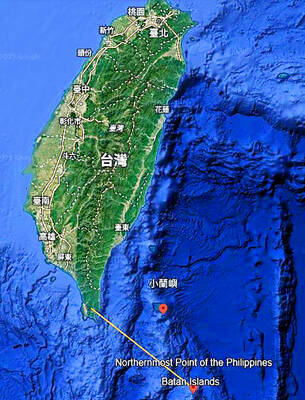Significant progress has been made in improving the imaging capabilities of Formosat-5, a National Space Organization (NSPO) official said yesterday, adding that the imagery can be used for disaster prevention.
Formosat-5, the nation’s first domestically developed satellite, was launched on Aug. 25 from Vandenberg Air Force Base in California. It was designed to deliver black-and-white images with 2m resolution and color images with 4m resolution.
While the images transmitted on Sept. 8 were blurry and tainted with light spots, NSPO officials denied there were any defects in any of the satellite’s components.

Photo: CNA
Later that month, the agency formed an advisory body of nine experts who offered advice on image adjustment and on identifying the cause of the imaging problem.
Images from Formosat-5 have achieved 5m resolution in color and 3m resolution in black and white when they are properly processed, NSPO Deputy Director-General Yu Shiann-jen (余憲政) told a news conference in Taipei.
While the images are sufficient for disaster prevention, urban planning and mapping would require greater resolution, he said.
Over the past three months, the agency has adopted three improvement measures: adjusting the temperature of the imaging facility, changing the altitude of the satellite and processing images through “deconvolution,” Yu said, adding that only the last measure worked well.
He illustrated the improvement by showing images taken by the satellite of Taipei, Nantou County, San Francisco International Airport and Davis-Monthan Air Force Base in Arizona, which were clearer than their counterparts from September.
The agency has collected more than 1,000 sets of images from the satellite, Yu said.
Davis-Monthan — best known for its so-called “boneyard” for decommissioned US government aircraft — has since the 1970s become the US military’s reference site to test aerial images, said National Chiao Tung University professor Shih Tien-yuan (史天元), a member of the advisory body.
While the root cause of the focus problem has yet to be confirmed, vibration during the satellite’s launch is one possible factor, National Central University professor Liang Chao-wen (梁肇文) said, adding that the design, composition and testing procedures of the satellite would be re-examined.
To make image processing more efficient, the agency plans to purchase new equipment with graphics processing unit systems next year, Yu said.
Asked whether the agency has a timetable for the problem to be completely fixed, Yu said it hopes to make images available to clients in August or September next year, while admitting that the time frame would be a two-month delay.

SECURITY: As China is ‘reshaping’ Hong Kong’s population, Taiwan must raise the eligibility threshold for applications from Hong Kongers, Chiu Chui-cheng said When Hong Kong and Macau citizens apply for residency in Taiwan, it would be under a new category that includes a “national security observation period,” Mainland Affairs Council (MAC) Minister Chiu Chui-cheng (邱垂正) said yesterday. President William Lai (賴清德) on March 13 announced 17 strategies to counter China’s aggression toward Taiwan, including incorporating national security considerations into the review process for residency applications from Hong Kong and Macau citizens. The situation in Hong Kong is constantly changing, Chiu said to media yesterday on the sidelines of the Taipei Technology Run hosted by the Taipei Neihu Technology Park Development Association. With

CARROT AND STICK: While unrelenting in its military threats, China attracted nearly 40,000 Taiwanese to over 400 business events last year Nearly 40,000 Taiwanese last year joined industry events in China, such as conferences and trade fairs, supported by the Chinese government, a study showed yesterday, as Beijing ramps up a charm offensive toward Taipei alongside military pressure. China has long taken a carrot-and-stick approach to Taiwan, threatening it with the prospect of military action while reaching out to those it believes are amenable to Beijing’s point of view. Taiwanese security officials are wary of what they see as Beijing’s influence campaigns to sway public opinion after Taipei and Beijing gradually resumed travel links halted by the COVID-19 pandemic, but the scale of

A US Marine Corps regiment equipped with Naval Strike Missiles (NSM) is set to participate in the upcoming Balikatan 25 exercise in the Luzon Strait, marking the system’s first-ever deployment in the Philippines. US and Philippine officials have separately confirmed that the Navy Marine Expeditionary Ship Interdiction System (NMESIS) — the mobile launch platform for the Naval Strike Missile — would take part in the joint exercise. The missiles are being deployed to “a strategic first island chain chokepoint” in the waters between Taiwan proper and the Philippines, US-based Naval News reported. “The Luzon Strait and Bashi Channel represent a critical access

Pope Francis is be laid to rest on Saturday after lying in state for three days in St Peter’s Basilica, where the faithful are expected to flock to pay their respects to history’s first Latin American pontiff. The cardinals met yesterday in the Vatican’s synod hall to chart the next steps before a conclave begins to choose Francis’ successor, as condolences poured in from around the world. According to current norms, the conclave must begin between May 5 and 10. The cardinals set the funeral for Saturday at 10am in St Peter’s Square, to be celebrated by the dean of the College